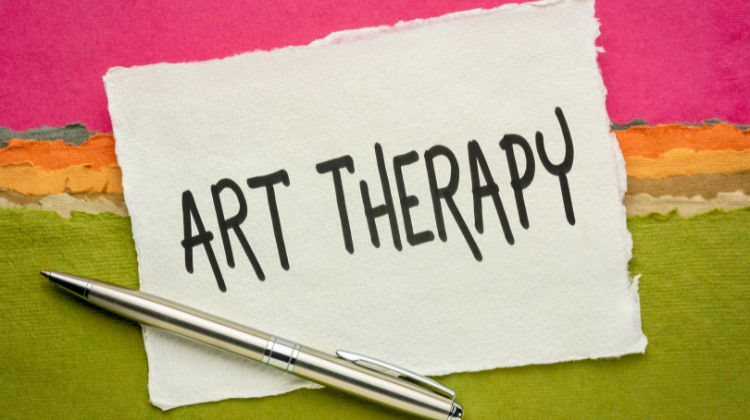Benefits of Art Therapy for Mental Health Creativity & Recovery 2024

Art therapy combines the disciplines of art and psychology into a therapy technique for a variety of conditions. The purpose is not to boost your art skills but rather to use your creative mind to benefit your mental health and overall well-being. This form of therapy is often used as a complementary therapy to other mental health treatments.
Art therapy conducted by a credentialed art therapist can help improve symptoms of mental illness such as anxiety or stress and potentially unlock new healing pathways. Artistic ability is not required to benefit from art therapy; simply an open mind to explore your creative mind.
Benefits of Art Therapy for Mental Health
Art therapy has been studied in patients with schizophrenia, depression, post-traumatic stress disorder, trauma, and anxiety, to name a few.
Participating in art therapy sessions can provide a range of benefits for those struggling with psychological symptoms. The benefits of art therapy may include
- Improvement in self-awareness
- Reduction of symptoms such as stress, anxiety[1], pain, poor mood, and negative thoughts
- Improving communication skills and self-expression
- Boosting social skills if part of a group setting
- Improved problem-solving skills
- Building self-esteem
Creating art encourages you to tap into your imagination to view problems in a new way, express emotions in a unique form and complement the healing process.
In the simplest form, it is an exercise in mindfulness[2], which is an exercise of self-awareness of the moment without the constraints of judgment; it has a host of benefits for overall well-being. It is a chance to turn inward and find moments of calm in a hectic world.
We all tend to go through the motions of life with just “muscle memory,” and mindfulness gets us out of that trance to actually relate to our lives with a perception that had been ignored. As it turns out, art is all about perception.
During an art therapy session, the focus is on the creative process more than the technique. A therapist will guide your artwork. Expect questions about your goals as well as your mental health and medical history to get started.
While you are making art, you will be asked to consider the emotions, memories, or other reactions that are coming to the surface during the process. The goal is to create art that expresses your inner world.
In other words, you’ve “perceived” your status; now show it through your art.
Reflecting on your art throughout the process builds self-awareness, the ability to express thoughts or emotions, and then outwardly communicate those effectively. These skills can have a huge benefit in the greater healing process.
A boost in self-esteem over your artistic accomplishments is also a natural consequence of such creative activities. You may even learn something new about yourself by stimulating a different part of your creative mind.
Art Therapy
There is evidence[3] of the use of art in therapeutic rituals in many ancient cultures. The modern practice of art therapy has roots in the 1960s. The American Art Therapy Association[4] was founded in 1969 to advance the professional practice of art therapy as a mental health discipline.
There are lots of ways the term art therapy may be used. Simply coloring at home might be termed art therapy. But true art therapy is conducted by credentialed art therapists, usually with a background in psychology and training in art.
A credentialed therapist[5] holds a master’s degree in art therapy and has passed an exam from the art therapy credentials board, along with continuing education requirements. In many states, the art therapy practice is also regulated by licensing programs. When seeking art therapy, choosing a professional provider with these qualifications is important.
Art therapy is often used with other therapeutic methods such as individual talk therapy or cognitive behavioral therapy (CBT)[6]. It may be done as an individual or in a group.
Other creative therapies such as dance or music therapy live in the same realm as art therapy. However, an art therapist will use different types of tactile art mediums as part of therapy. These may include
- Pottery
- Sculpture
- Drawing
- Painting
- Photography
- Finger Painting or Doodling
- Coloring
- Collage
- Textiles/Weaving
The sensory experience of art can be a powerful tool that transcends the verbal experience of traditional therapy. What is difficult to express in words can be expressed in art.
Art therapy is conducted in a variety of settings, including private treatment centers, community centers, art studios, group homes, schools, nursing homes, and even correctional facilities. To get the most benefit, art therapy should be an ongoing therapeutic practice over several sessions.
Who Might Benefit from Art Therapy?
Art therapy can be applied to many different mental health problems. It is most often utilized with individuals suffering from depression, anxiety, stress, substance abuse, and emotional trauma. Art therapists also work with a variety of age ranges, from children[7] to young adults, as well as older adults[8]. There is no limit to when and to whom it might benefit.
You do not need to be a great artist or have any prior artistic experience to participate in art therapy! Only the willingness to engage and be open to the experience of making art.
There is a lot of research[9] into the benefits of art therapy for different conditions. The challenges in the field are the wide variety of techniques, processes, and criteria for success. Because it is also used in coordination with other forms of treatment, separating the benefits of art therapy alone can be tricky.
But while there is still much to define regarding the professional practice of art therapy[10], the positive effects many patients report from their creative sessions continue to propel more research forward.
Significant evidence-based research was examined in a 2018 review[11] of 27 studies conducted between 2000 and 2017 and published in Frontiers in Psychology. Overall the review indicated a lack of high-quality data from controlled trials but found continued progress in the research field.
This review separated the research into seven different categories of medical care, including cancer patients, the elderly, prison inmates, trauma patients, those with medical conditions (such as heart failure), those diagnosed with mental illness, and undiagnosed mental health conditions.
The most promising results were from those studies that addressed subjects dealing with “everyday challenges” such as burnout at work and daily stress.
A study[12] published in the Journal of the American Art Therapy Association examined changes in levels of the stress hormone, cortisol[13] as a measure of stress reduction in art therapy. Thirty-nine subjects’ cortisol levels (via saliva) were tested before and after an art therapy session.
About 75% of participants had a significantly reduced cortisol level following the session. They were also asked some qualitative questions regarding their experience, and the most common answers were feelings of relaxation, enjoyment, and freedom from constraints in the process.
Unfortunately, research has not supported a significant benefit for severe clinical mental[14] illnesses such as psychosis[15], schizophrenia[16], severe depression, or bipolar disorder. Other effective behavioral therapies, such as cognitive behavioral therapy, are of primary importance for severe mental illness treatment.
If you think you may benefit from art therapy, seek professional medical advice from your doctor or therapist as to incorporating creative art into your treatment plan. There may even be convenient online therapy options that include elements of art therapy.
Even if you don’t have any mental health issues, the mindfulness of art therapy can help you identify internal struggles of which you weren’t aware.
The Bottom Line: Is Art Therapy Effective?
The clinical benefits of art therapy are still being determined, but the bottom line is that art therapy is a low-risk complementary therapy option with likely benefits for anxiety, stress, poor mood, pain, and negative thinking. The measurable effects of art therapy can be difficult to ascertain, but many people come away from art therapy with an improved mood and reduced stress.
While it hasn’t been proven to benefit severe mental illness, e.g., schizophrenia or bipolar depression, It certainly won’t hurt to incorporate it as part of a robust treatment plan and may help manage the everyday challenges of mental health. Overall it has the potential to do more good than harm (if any). At the very least, you gain the opportunity for creative expression and potentially some new art pieces to display with pride.
It is important to engage with a trained professional in a suitable setting for effective art therapy. While you may want to do some individual art therapy with coloring books at home, do not underestimate the truly effective work of art therapy that should be done with a certified or credentialed art therapist.
+ 16 sources
Health Canal avoids using tertiary references. We have strict sourcing guidelines and rely on peer-reviewed studies, academic researches from medical associations and institutions. To ensure the accuracy of articles in Health Canal, you can read more about the editorial process here
- Abbing, A., de Sonneville, L., Baars, E., Bourne, D. and Swaab, H. (2019). Anxiety reduction through art therapy in women. Exploring stress regulation and executive functioning as underlying neurocognitive mechanisms. PLOS ONE, [online] 14(12), p.e0225200. doi:10.1371/journal.pone.0225200.
- Schuman-Olivier, Z., Trombka, M., Lovas, D.A., Brewer, J.A., Vago, D.R., Gawande, R., Dunne, J.P., Lazar, S.W., Loucks, E.B. and Fulwiler, C. (2020). Mindfulness and Behavior Change. Harvard Review of Psychiatry, [online] 28(6), pp.371–394. doi:10.1097/hrp.0000000000000277.
- Junge, M.B. (2015). History of Art Therapy. The Wiley Handbook of Art Therapy, [online] pp.7–16. doi:10.1002/9781118306543.ch1.
- American Art Therapy Association. (2014). About the American Art Therapy Association. [online] Available at: https://arttherapy.org/about/
- American Art Therapy Association. (2014). Credentials and Licensure – American Art Therapy Association. [online] Available at: https://arttherapy.org/credentials-and-licensure/
- NHS Choices (2022). Overview – Cognitive behavioural therapy (CBT). [online] Available at: https://www.nhs.uk/mental-health/talking-therapies-medicine-treatments/talking-therapies-and-counselling/cognitive-behavioural-therapy-cbt/overview/.
- Woollett, N., Bandeira, M. and Hatcher, A. (2020). Trauma-informed art and play therapy: Pilot study outcomes for children and mothers in domestic violence shelters in the United States and South Africa. Child Abuse & Neglect, [online] 107, p.104564. doi:10.1016/j.chiabu.2020.104564.
- Gall, D.J., Jordan, Z. and Stern, C. (2015). Effectiveness and meaningfulness of art therapy as a tool for healthy aging: a comprehensive systematic review protocol. JBI Database of Systematic Reviews and Implementation Reports, [online] 13(3), pp.3–17. doi:10.11124/jbisrir-2015-1840.
- Newland, P. and Bettencourt, B.A. (2020). Effectiveness of mindfulness-based art therapy for symptoms of anxiety, depression, and fatigue: A systematic review and meta-analysis. Complementary Therapies in Clinical Practice, [online] 41, p.101246. doi:10.1016/j.ctcp.2020.101246.
- Van Lith, T. (2016). Art therapy in mental health: A systematic review of approaches and practices. The Arts in Psychotherapy, [online] 47, pp.9–22. doi:10.1016/j.aip.2015.09.003.
- Regev, D. and Cohen-Yatziv, L. (2018). Effectiveness of Art Therapy With Adult Clients in 2018—What Progress Has Been Made? Frontiers in Psychology, [online] 9. doi:10.3389/fpsyg.2018.01531.
- Kaimal, G., Ray, K. and Muniz, J. (2016). Reduction of Cortisol Levels and Participants’ Responses Following Art Making. Art Therapy, [online] 33(2), pp.74–80. doi:10.1080/07421656.2016.1166832.
- Russell, G. and Lightman, S. (2019). The human stress response. Nature Reviews Endocrinology, [online] 15(9), pp.525–534. doi:10.1038/s41574-019-0228-0.
- Chiang, M., Reid-Varley, W.B. and Fan, X. (2019). Creative art therapy for mental illness. Psychiatry Research, [online] 275, pp.129–136. doi:10.1016/j.psychres.2019.03.025.
- Attard, A. and Larkin, M. (2016). Art therapy for people with psychosis: a narrative review of the literature. The Lancet Psychiatry, [online] 3(11), pp.1067–1078. doi:10.1016/s2215-0366(16)30146-8.
- Isabel Ruiz, M., Aceituno, D. and Rada, G. (2017). Art therapy for schizophrenia? Medwave, [online] 17(Suppl1), pp.e6845–e6845. doi:10.5867/medwave.2017.6845.



